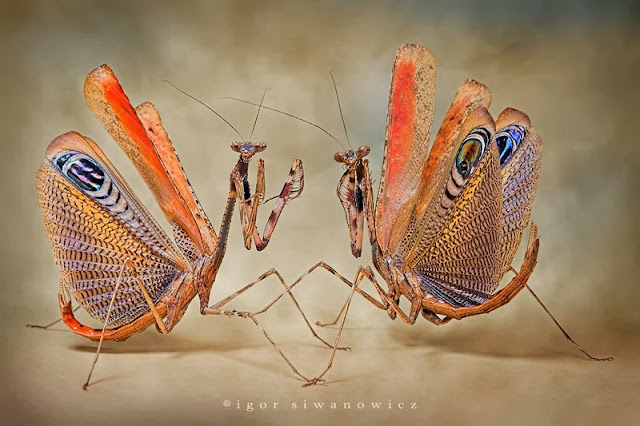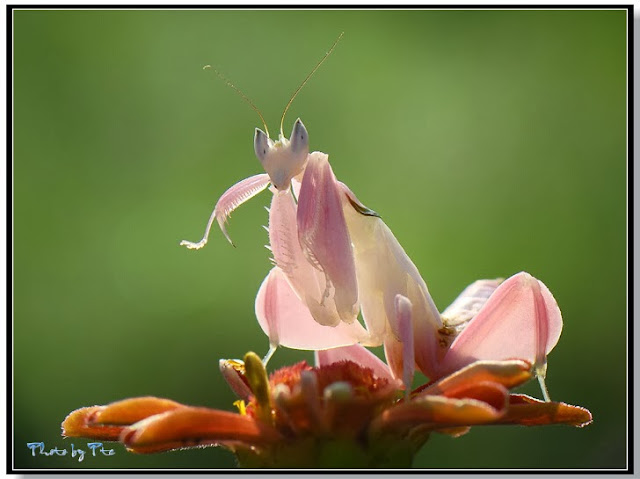What we never know about “The mantis”
The praying mantis is named for its prominent front legs, which are bent and held together at an angle that suggests the position of prayer. The larger group of these insects is more properly called the praying mantids. Mantis refers to the genus mantis, to which only some praying mantids belong.
By any name, these fascinating insects are formidable predators. They have triangular heads poised on a long "neck," or elongated thorax. Mantids can turn their heads 180 degrees to scan their surroundings with two large compound eyes and three other simple eyes located between them.
Typically green or brown and well camouflaged on the plants among which they live, mantis lie in ambush or patiently stalk their quarry. They use their front legs to snare their prey with reflexes so quick that they are difficult to see with the naked eye. Their legs are further equipped with spikes for snaring prey and pinning it in place.
Moths, crickets, grasshoppers, flies, and other insects are usually the unfortunate recipients of unwanted mantid attention. However, the insects will also eat others of their own kind. The most famous example of this is the notorious mating behavior of the adult female, who sometimes eats her mate just after—or even during—mating. Yet this behavior seems not to deter males from reproduction.
Females regularly lay hundreds of eggs in a small case, and nymphs hatch looking much like tiny versions of their parents.
Praying for Prey When lying in ambush for prey, all mantises strike the same "prayerful" posture of folded front legs held tight to the body. They use their back and middle legs to grasp a twig or stem. When an insect comes into reach, the mantis strikes out, impales, and holds the prey with its spiny, or toothed, front legs. The strike occurs in the blink of an eye. A Carolina mantis can actually strike twice before a housefly can open its wings to attempt an escape.
Chowing Down Voracious is the word that best describes mantids' appetites. They eat caterpillars, butterflies, flies, bees, wasps, and moths. Big mantids in the tropics take lizards, hummingbirds, and small frogs. Praying mantises hunt during the day and night. Frequently, they position themselves near porch lights and streetlights to capture moths and other night-flying insects. "They are just programmed to eat. It's what they do," Digman says.
Camouflage Mantids are big, slender insects; they're 2 to 4 inches long when fully grown. Ranging from green to brown in color, they blend in well among grasses and shrubs. They're found in fields, pastures, ditches, and gardens. In temperate climates, mantids hatch in spring, mature by late summer, and die with the onset of cold weather.
Finding Egg Cases Each fall, females deposit eggs in frothy brown cases that they attach to twigs. The cases harden, protecting the eggs from birds and weather. If you find them, you can remove the egg cases and put them into your garden. Or you can buy egg cases from beneficial-insect suppliers. The mantids aren't pets, however, and it's unlikely that they'll hang around your garden long after hatching, says Digman. "Unless you have a lot of bugs in your garden, mantids will move on," he says. "They need to eat."
Swivel Heads The ability of mantids to cock their heads from side to side and even look backward is unique among insects. This dexterity and their large compound eyes and muscular mouthparts, which can crack open the armor of many insects, give mantids a fearsome, unsettling appearance, but they are harmless to humans. They neither bite nor sting. They seem fearless, as well. When approached by a bigger animal, mantids will rear up on their back legs and extend their wings to appear more threatening—hence their given folk name, "rear-horse."
Sex to Die For Cannibalism is common among mantids. After hatching, the young will eat one another if they don't immediately find prey. The adult female may consume her own mate, severing the male's head while the pair are in the act of copulation.
"Severing the head does a couple of things. It actually stimulates the male to copulate and keeps him there so he remains in the act. And it guarantees the female that the male is not going to eat her first," Digman says.
Love-hungry males inherently understand the risk of this rough sex and will try to take the females by surprise and jump away immediately after mating.
Mantises have two grasping, spiked forelegs ("raptorial legs") in which prey items are caught and held securely. In most insect legs, including the posterior four legs of a mantis, the coxa and trochanter combine as an inconspicuous base of the leg; in the raptorial legs however, the coxa and trochanter combine to form a segment about as long as the femur, which is a spiky part of the grasping apparatus (see illustration). Located at the base of the femur are a set of discoidal spines, usually four in number, but ranging from zero to as many as five depending on the species. These spines are preceded by a number of tooth-like tubercles, which, along with a similar series of tubercles along the tibia and the apical claw near its tip, give the foreleg of the mantis its grasp on its prey. The foreleg ends in a delicate tarsus made of between four and five segments and ending in a two-toed claw with no arolium and used as a walking appendage.
The mantis thorax consists of a prothorax, a mesothorax, and a metathorax. In all species apart from the genus Mantoida, the prothorax, which bears the head and forelegs, is much longer than the other two thoracic segments. The prothorax is also flexibly articulated, allowing for a wide range of movement of the head and forelimbs while the remainder of the body remains more or less immobile. The articulation of the neck is also remarkably flexible; some species of mantis can rotate the head nearly 180 degrees.
Mantises may have a visual range of up to 20 metres. Their compound eyes may comprise up to 10,000 ommatidia. The eyes are widely spaced and laterally situated, affording a wide binocular field of vision) and, at close range, precise stereoscopic vision. The dark spot on each eye is a pseudopupil. As their hunting relies heavily on vision, mantises are primarily diurnal. Many species will however fly at night, and then may be attracted to artificial lights. Nocturnal flight is especially important to males in search of less-mobile females that they locate by detecting their pheromones. Flying at night exposes mantises to fewer bird predators than diurnal flight would. Many mantises also have an auditory thoracic organ that helps them to avoid bats by detecting their echolocation and responding evasively.
Mantises can be loosely categorized as being macropterous (long-winged), brachypterous (short-winged), micropterous (vestigial-winged), or apterous (wingless). If not wingless, a mantis will have two sets of wings: the outer wings, or tegmina, are usually narrow, opaque, and leathery. They function as camouflage and as a shield for the hind wings. The hind wings are much broader, more delicate, and transparent. They are the main organs of flight, if any.
Brachypterous species are at most minimally capable of flight, other species not at all. The wings are mostly erected in these mantids for alarming enemies and attracting females. Even in many macropterous species the female is much heavier than the male, has much shorter wings, and rarely takes flight if she is capable of it at all.
True
Facts About The Mantis
Eaten Alive by a Mantis - Wildlife On One: Enter The Mantis - BBC
Now..you know the Mantis !



























<3
ReplyDelete